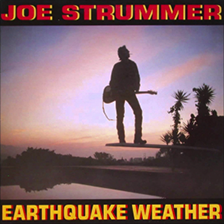Three Songs about Falling Asleep on your Feet
On hearing that his sons intended to pursue careers as rock stars, Anthony Farina reportedly warned: "the only stars are in the sky," which may have been truer in 1957 than it is today. Nowadays, if you really hit it big as a celebrity your star doesn't end up in the sky at all but, instead, embedded in cement to be walked upon or gawked upon in loving tribute when the ceremony is over.
A few years after his seemingly-sage admonition, Anthony's two kids, Santo and Johnny Farina, did, in fact, achieve a #1 hit – though none after – with the first and foremost "Sleep Walk", an instrumental which, despite having no lyrics, still managed to say quite a bit about a better and dreamier version of America at that moment and since. According to their wistful and melancholy melody, it's entirely possible to be both broken-hearted and hopeful all at once when you're walking home late on hot summer night reconsidering the day and reflecting on your station in life. The song is so good at creating that particular sensory experience, in fact, that it set an early high-water mark for so many of the reverby rock instrumentals that thereafter glued great albums together. Honestly, I'm surprised to see it left off Dylan's "The Philosophy of Modern Song," though I suppose it may have been a clerical oversight owing primarily to its wordlessness.
The sentiment, though, was certainly not lost on Joe Strummer who in 1989 – thirty years after the original tune hit the charts and on an album filled with post-Clash ruminations about America – included his own (and our second) "Sleepwalk" on his solo effort Earthquake Weather. Strummer's "Sleepwalk" (condensed to one word, rather than two) is tucked at the back of the LP, a postscript to a raucous roadtrip, and alludes to Santo and Johnny's original with its own hesitating melody from the outset. Standing against a California sunset, levitating just above a swimming pool and a row of palm trees on the album cover*, it's easy to imagine the early-onset mid-life reflection Strummer had encountered in Los Angeles.He sings:
I went to find, some piece of mind
What good would it be?
What good would it be
If you could change every heartache
that ran through your life and mine?
That idea – that there'd be a chance to somehow undo past heartbreak or that's it's simply not worth it given the opportunity to move on – is, for me, at least part of the magic that sits underneath the original "Sleep Walk" melody. Leave it to Strummer to pull off that trick.
By 1994, you'd expect that a then 40-year-old "avant-garage" songwriter from Cleveland would've given up for good on a 35-year-old instrumental one hit wonder, but you'd be wrong. A keen observer of bygone Americana – not the kind you hear on XM Radio but the sketchy roadside entrapment and deferred dreams kind – David Thomas (and Jim Jones) of Pere Ubu give us our third 'Sleepwalk,' though this time – purposefully, I'm sure – the title is again divided into two verbs, "Sleep" and "Walk" as a matter of directive. In the video, we get to watch just that as the band trudges through the downtown snow before they really buffed out the rough edges of the city. Thomas starts by cautioning against the magnetic attraction and dangers of reflection to the point of distraction (or, the pull to "relinquish substance for shadow") as per Aesop:
Somewhere, I see a face in a stream
I watch the dust in a beam
I work harder and harder to break away
From the grip of a dream
Then – right before their own obvious instrumental coda to the original "Sleep Walk" – Thomas and 'Ubu shake us all awake, returning us to earth and to Anthony Farina's observation about the stars above:
It ain't me
Don't watch the sky, brother
It ain't me
Or the ground far below
– Jon Roket
Jon writes on music, creativity, art, and eCommerce at Unclumsy.com
Addendum: The original Santo & Johnny "Sleep Walk" is often listed online and in various cover versions as "Sleepwalk," the single verb – and that would seem to make sense given the lilt of the tune – however, per ASCAP/BMI look-up, it's quite officially two words. Interestingly, Santo and Johnny's mother – she was, presumably, more encouraging of their career than her husband – wrote a set of lyrics for the 1959 Betsy Brye version that, while labled on the 45 itself as 'Sleep Walk,' is filed under "Sleepwalk" (one word) in ASCAP/BMI's Songview catalog.
Photo credit for the Earthquake Weather album cover: Josh Cheuse. He's produced what looks to be an incredible book – Print the Myth, Joe Strummer Portraits 1981-2002 – about his 20 year work span with Strummer. Click here for a short video about that project.
